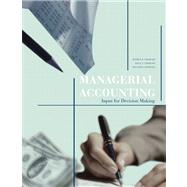This text is written as an integrated work in managerial accounting, and is intended for use as a basic text for
students after completing a first semester or quarter course in financial accounting at either the undergraduate or
graduate level.
This text is organized around the following major areas of managerial accounting:
An Overview of Managerial Accounting. In this section, the text discusses the uses of managerial accounting and contrasts the type and use of information provided by managerial accounting and financial accounting (Chapter 1). Chapter 2 focuses on basic cost information and behavior. In this chapter we distinguish between the different types of costs incurred by organizations. In addition, this chapter discusses the behavior of these costs with changes in activity as well as the effect of cost behavior on managerial decisions.
Cost Accumulation. Chapters 3 through 5 illustrate the process through which the organization accumulates costs with its products and services. In Chapter 3, we focus on production and service processes that require different levels of effort across individual jobs (job-order costing). Chapter 4 illustrates the cost accumulation process for manufacturing environments characterized by the production of a large number of similar products (process costing). Chapter 5 focuses on the process through which overhead costs are accumulated with the organization’s inventory and services. The dedication of an entire chapter to overhead costs is considered necessary given the importance of controlling overhead costs to organizations in manufacturing inventory and providing services.
The Use of Managerial Accounting Information. Chapters 6 through 11 describe various uses of managerial accounting information. Topics discussed in these chapters include variable costing and costvolume-profit analysis (Chapter 6), standard costing and determination of variances (Chapter 7), budgeting (Chapter 8), responsibility accounting (Chapter 9), short-term managerial decisions (Chapter 10), and capital budgeting (Chapter 11). In these chapters, the basic principles of cost behavior and cost accumulation discussed in the preceding two sections are applied to important decisions facing managers in today’s
business world.








